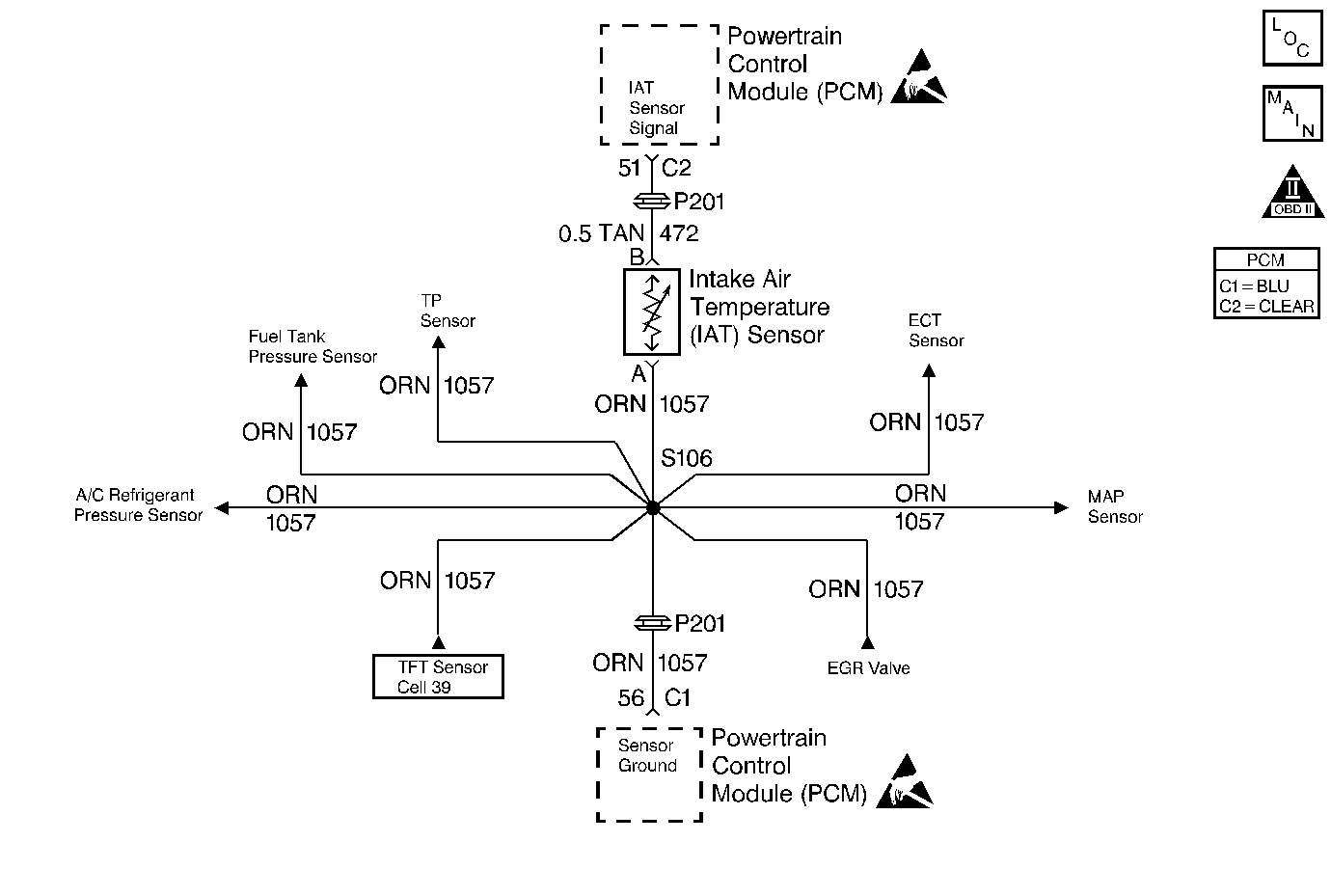
Circuit Description
The Intake Air Temperature (IAT) sensor is a thermistor which measures the temperature of the air entering the engine. The PCM applies 5V through a pull-up resistor to the IAT sensor. When the intake air is cold, the sensor resistance is high and the PCM will monitor a high signal voltage on the IAT signal circuit. If the intake air is warm, the sensor resistance is lower causing the PCM to monitor a lower voltage. DTC P0112 will set when the PCM detects an excessively low signal voltage on the intake air temperature sensor signal circuit.
Conditions for Setting the DTC
| • | No active ECT sensor, MAF sensor or VSS DTC present. |
| • | Engine running for over 30 seconds. |
| • | Vehicle speed is greater than 25 mph. |
| • | IAT signal voltage indicates an intake air temperature greater than 139°C (282°F). |
| • | The above conditions are present for at least 30 seconds. |
Action Taken When the DTC Sets
| • | The PCM will illuminate the malfunction indicator lamp (MIL) during the second consecutive trip in which the diagnostic test has been run and failed. |
| • | The PCM will store conditions which were present when the DTC set as Freeze Frame and Failure Records data. |
Conditions for Clearing the MIL/DTC
| • | The PCM will turn OFF the MIL during the third consecutive trip in which the diagnostic has been run and passed. |
| • | The History DTC will clear after 40 consecutive warm-up cycles have occurred without a malfunction. |
| • | The DTC can be cleared by using the scan tool. |
Diagnostic Aids
Check for the following conditions:
| • | Poor connection at PCM. Inspect harness connectors for backed out terminals, improper mating, broken locks, improperly formed or damaged terminals, and poor terminal to wire connection |
| • | Damaged harness. Inspect the wiring harness for damage. If the harness appears to be OK, observe the IAT display on the scan tool while moving connectors and wiring harnesses related to the IAT sensor. A change in the IAT display will indicate the location of the fault. |
If DTC P0112 cannot be duplicated, the information included in the Fail Records data can be useful in determining vehicle mileage since the DTC was last set.
Test Description
Number(s) below refer to the Step number(s) on the Diagnostic Chart:
-
Verifies that the fault is present.
-
If DTC P0112 can be repeated only by duplicating the Fail Records conditions, refer to the Temperature vs. Resistance Value table. The table may be used to test the IAT sensor at various temperatures to evaluate the possibility of a shifted sensor that may be shorted above or below a certain temperature. If this is the case, replace the IAT sensor. If the IAT sensor appears to be OK, the fault is intermittent refer to Diagnostic Aids.
-
This vehicle is equipped with a PCM which utilizes an Electrically Erasable Programmable Read Only Memory (EEPROM). When the PCM is being replaced, the new PCM must be programmed. Refer to PCM Replacement and Programming Procedures in Powertrain Control Module (PCM) and Sensors.
Step | Action | Value(s) | Yes | No |
|---|---|---|---|---|
1 | Was the Powertrain On-Board Diagnostic System Check Performed? | -- | Go to Powertrain OBD System Check | |
Ignition ON, observe the Intake Air Temp display on the scan tool Eng 1 data list. Is Intake Air Temp. greater than specified value? | 130°C (266°F) | |||
Does scan tool indicate DTC P0112 failed this ignition? | -- | Refer to Diagnostic Aids | ||
4 |
Is Intake Air Temperature below the specified value? | -30°C (-22°F) | ||
5 |
Is IAT sensor signal circuit shorted to ground? | -- | ||
6 | Replace IAT Sensor. Is action complete? | -- | -- | |
7 | Repair IAT sensor signal circuit. Is action complete? | -- | -- | |
Replace the PCM. Important: Replacement PCM must be programmed. Refer to PCM Replacement/Programming. Is action complete? | -- | -- | ||
9 |
Does scan tool indicate DTC P0112 failed this ignition? | -- | Repair complete |
